El
Corazon de Cuba
Educational Program
Agricultural Baseline
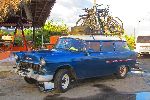 The next morning it was time to leave our lodging in
Havana and begin to learn about the Cuban economy and culture that is further a field.
The next morning it was time to leave our lodging in
Havana and begin to learn about the Cuban economy and culture that is further a field.
We packed our bikes, luggage and bodies into and onto one of Cuba's famous classic American automobiles. It is hard to name exactly what they are because it is not unusual for the chassis to be of one makes, the shell of another, and the engine from an entirely different century and country.
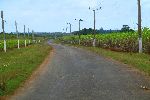
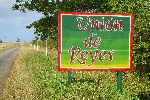 We
headed east for 160 kilometers into the Cuban heartland, a broad
flat plain that stretches for several hundred miles toward the
geographical center of the island.
We
headed east for 160 kilometers into the Cuban heartland, a broad
flat plain that stretches for several hundred miles toward the
geographical center of the island.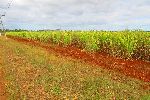
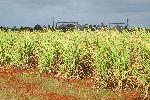 The
area of central Matanzas province is the great plains of Cuba. For centuries sugar cane has
been king in this regions. Over that time the fortunes of the region has
risen and fallen on the plight of sugar cane. The legacy of this economy is
still present in railroad tracks leading into towns and out to the fields,
and the occasional skeleton of a large mill. There is still a lot of fields
under sugar cultivations, but there are also an increasing number of
exceptions.
The
area of central Matanzas province is the great plains of Cuba. For centuries sugar cane has
been king in this regions. Over that time the fortunes of the region has
risen and fallen on the plight of sugar cane. The legacy of this economy is
still present in railroad tracks leading into towns and out to the fields,
and the occasional skeleton of a large mill. There is still a lot of fields
under sugar cultivations, but there are also an increasing number of
exceptions.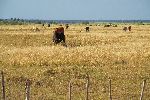 Among
the alternative programs is cattle. Cows are a frequent topic of
conversation. Among the lines that get repeated are, "One inept official's
bad policies can destroy the national herd in a year. It takes a thousand
farmers ten years to repair the damage and build the herd back up."
Among
the alternative programs is cattle. Cows are a frequent topic of
conversation. Among the lines that get repeated are, "One inept official's
bad policies can destroy the national herd in a year. It takes a thousand
farmers ten years to repair the damage and build the herd back up."On the books, cattle are a serious issue: "Cows are more precious than human life in Cuba. You can get eight years in prison for killing a man, and twenty years in prison for illegally killing a cow."
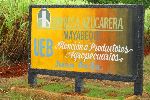
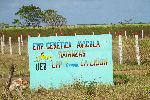
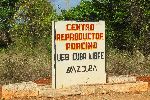
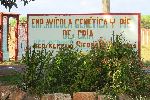
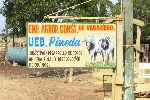
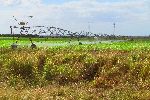 If
you go to Pinar del Rio Province, UEB (Unidades Empresariales
de Base) has connections with
mining and forestry. In this area, UEB has operations in cattle, poultry,
sugar, rice, fruit, and almost every other agricultural commodity. UEB is
a conglomerate for industrial enterprises.
If
you go to Pinar del Rio Province, UEB (Unidades Empresariales
de Base) has connections with
mining and forestry. In this area, UEB has operations in cattle, poultry,
sugar, rice, fruit, and almost every other agricultural commodity. UEB is
a conglomerate for industrial enterprises.Most agricultural operations that are capital intensive, like large irrigation and green house projects are likely to be connected to UEB.
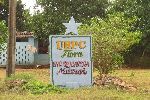
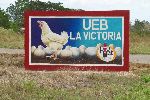
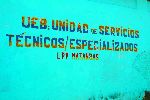
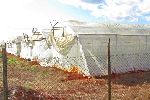
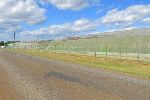
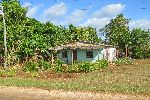 Rural
housing, bohio, tends not to be clustered in villages, or even
hamlets. They tend to be similar in size and basic, but each is individualized.
The front often presents a central door, between two windows and a front porch,
with a couple of rocking chairs, but beyond that the similarities might end:
Some are made from cement block and other wood. Roofs have a variety of designs
and building materials. And, landscaping always individualizes a homestead.
Rural
housing, bohio, tends not to be clustered in villages, or even
hamlets. They tend to be similar in size and basic, but each is individualized.
The front often presents a central door, between two windows and a front porch,
with a couple of rocking chairs, but beyond that the similarities might end:
Some are made from cement block and other wood. Roofs have a variety of designs
and building materials. And, landscaping always individualizes a homestead.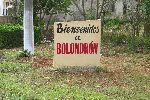
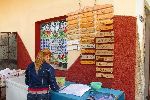
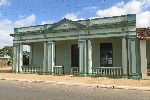
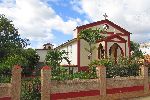 Agricultural
towns are spaced throughout the region. Bolondrón seems pretty typical: On the clean
and well repaired main street there is Iglesia Episcopal "San Pablo", a
Masonic Lodge, snack shops, some general stores, and a lot of residential.
Agricultural
towns are spaced throughout the region. Bolondrón seems pretty typical: On the clean
and well repaired main street there is Iglesia Episcopal "San Pablo", a
Masonic Lodge, snack shops, some general stores, and a lot of residential.
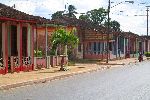 In this area, rural houses often are just whitewashed or unpainted, but at least
the street side of most buildings in the towns are painted in pastels colors
that are are so distinctive of Cuban buildings.
In this area, rural houses often are just whitewashed or unpainted, but at least
the street side of most buildings in the towns are painted in pastels colors
that are are so distinctive of Cuban buildings.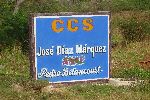 This
is a common style of sign in rural Pinar del Rio. ANAP is the Asociación
Nacional de Agricultores Pequeños (National Association of Small-holder
Farmers). CCS (Cooperativas de Créditos y Servicios) is an
ANAP program. The black lettering at the top is the name of the community, and
the lettering at the bottom is the district. ANAP was formed
in 1961 and its membership was limited to farmers whose land holdings were
less than 67 hectares. The government supported ANAP by providing
interest-free loans to its members. In 1977, ANAP supported the gradual
transformation of the private sector. Individual farmers were encouraged to
voluntarily join production co-operatives. By 1987, co-operative farms were
accounting for 63% of private land holdings nationally. Altogether 1,400
co-operative farms had 68,000 co-operative members. These numbers have since
grown considerably. In 2007, ANAP members
produce 52% of the vegetables, 67% of the corn, and 85% of the tobacco grown
in Cuba.
This
is a common style of sign in rural Pinar del Rio. ANAP is the Asociación
Nacional de Agricultores Pequeños (National Association of Small-holder
Farmers). CCS (Cooperativas de Créditos y Servicios) is an
ANAP program. The black lettering at the top is the name of the community, and
the lettering at the bottom is the district. ANAP was formed
in 1961 and its membership was limited to farmers whose land holdings were
less than 67 hectares. The government supported ANAP by providing
interest-free loans to its members. In 1977, ANAP supported the gradual
transformation of the private sector. Individual farmers were encouraged to
voluntarily join production co-operatives. By 1987, co-operative farms were
accounting for 63% of private land holdings nationally. Altogether 1,400
co-operative farms had 68,000 co-operative members. These numbers have since
grown considerably. In 2007, ANAP members
produce 52% of the vegetables, 67% of the corn, and 85% of the tobacco grown
in Cuba.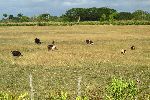 From
the time of the revolution to the first decade of the century, Cuba lost
more than two-thirds of its cattle population. Beef are still quite
rare but can be found in the market. But there seems to have been more
success at reversing Cuba's legendary milk shortage. Dairy products (milk
and cheese) have become regularly available. Pregnant woman and children
under 7, still get extra milk rations at a hugely subsidized price. It
should be noted that the scarcity of cattle here is understandable because
this is not a primary cattle raising area.
From
the time of the revolution to the first decade of the century, Cuba lost
more than two-thirds of its cattle population. Beef are still quite
rare but can be found in the market. But there seems to have been more
success at reversing Cuba's legendary milk shortage. Dairy products (milk
and cheese) have become regularly available. Pregnant woman and children
under 7, still get extra milk rations at a hugely subsidized price. It
should be noted that the scarcity of cattle here is understandable because
this is not a primary cattle raising area.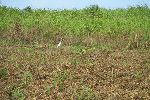 The
cattle egret come with cows. The bird that seeks out cattle (and
other large grazing mammals) to opportunistically feed on the insects they
carry and disturb. Originally native to parts of Asia, Africa and Europe, it
has undergone a rapid expansion in its distribution and successfully
colonized much of the rest of the world in the last century.
The
cattle egret come with cows. The bird that seeks out cattle (and
other large grazing mammals) to opportunistically feed on the insects they
carry and disturb. Originally native to parts of Asia, Africa and Europe, it
has undergone a rapid expansion in its distribution and successfully
colonized much of the rest of the world in the last century.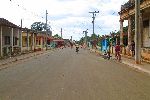
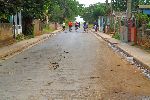
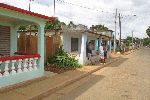
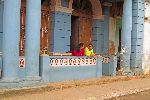 Guira
de Macurijes is little more than a village at the cross-roads, with farm field
stretching to the horizon in all directions. It might have a population of a
1000. From the road it has a calm countenance and the residence are happy to cast a smile to
some strangers passing through.
Guira
de Macurijes is little more than a village at the cross-roads, with farm field
stretching to the horizon in all directions. It might have a population of a
1000. From the road it has a calm countenance and the residence are happy to cast a smile to
some strangers passing through.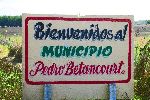 On
our route, you enter Pedro Betancourt through the past; on one side of the road
is the Cuba Libre Sugar Cane Factory, and on the other side is the cemetery.
On
our route, you enter Pedro Betancourt through the past; on one side of the road
is the Cuba Libre Sugar Cane Factory, and on the other side is the cemetery.
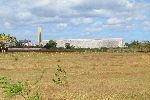 Cuba
Libre was the largest sugar / molasses mill in country. In 2002, the Ministry of
Sugar set in motion a plan to deactivate or repurpose about half of the sugar
mills in the country (of the 156 mills that existed at that time, 71 would
produce sugar, 14 would produce sugar and molasses destined as cattle feed, 5
would be converted into museums, 5 would be held in reserve and the remaining 61
would be dismantled.). Within a couple of years the target for sugar mills had
dropped into the forties. Cuba Libre is currently inactive, but it has not been
dismantled, repurposed industrially, or turned into a museum, so it is not clear
what its fate is. While Cuba Libre is the largest mill, many of those removed
from production were the smallest and least efficient, so sugar production was
impacted by the same percentage as the reduction in mills. And the output of
agricultural production was mitigated by switching to higher value crops, like
citrus, for example.
Cuba
Libre was the largest sugar / molasses mill in country. In 2002, the Ministry of
Sugar set in motion a plan to deactivate or repurpose about half of the sugar
mills in the country (of the 156 mills that existed at that time, 71 would
produce sugar, 14 would produce sugar and molasses destined as cattle feed, 5
would be converted into museums, 5 would be held in reserve and the remaining 61
would be dismantled.). Within a couple of years the target for sugar mills had
dropped into the forties. Cuba Libre is currently inactive, but it has not been
dismantled, repurposed industrially, or turned into a museum, so it is not clear
what its fate is. While Cuba Libre is the largest mill, many of those removed
from production were the smallest and least efficient, so sugar production was
impacted by the same percentage as the reduction in mills. And the output of
agricultural production was mitigated by switching to higher value crops, like
citrus, for example.
The future of some sugar mills might be tourism. Like the old cars that have become iconic in Cuba, the sugar plantations moved the cane from field to factory by steam powered locomotive. Modernization would have meant replacing these with diesel powered engines, but that didn't happen in Cuba. Cuba now possesses a large inventory steam engine which proffer the possibility for tourist-oriented, steam-powered train excursions through the countryside.
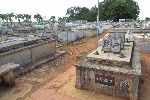
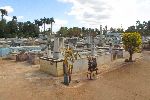 The
Pedro Betancourt cemetery is typical of cemeteries in Cuba. There are many
rows of family grave plots. The monument has a casket-length vault at one
end, which is deep enough to accommodate a stack of several caskets. At
the other end is a smaller, but equally deep vault for bone-boxes. When
the casket vault is full the oldest casket is removed and the remains are
transferred to a much smaller bone-box, which is re-interned to bone-box
vault, which can dozens and dozens of remains.
The
Pedro Betancourt cemetery is typical of cemeteries in Cuba. There are many
rows of family grave plots. The monument has a casket-length vault at one
end, which is deep enough to accommodate a stack of several caskets. At
the other end is a smaller, but equally deep vault for bone-boxes. When
the casket vault is full the oldest casket is removed and the remains are
transferred to a much smaller bone-box, which is re-interned to bone-box
vault, which can dozens and dozens of remains.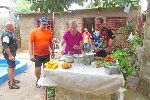
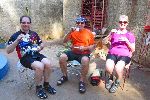 Back
in the present, in Pedro Betencourt we had a lunch buffet, and after-lunch coffee at the
house of a woman who had worked in support of the 1959 Revolution. She shared
much of her life with us, including dangerous work supplying Fidel's growing
army, training in the Sierra Maestra (mountains), and after the Revolution her
work as a teacher in the national literacy campaign, in a rual community. She
continues to be a strong supporter of the change that the Revolution brought to
Cuba.
Back
in the present, in Pedro Betencourt we had a lunch buffet, and after-lunch coffee at the
house of a woman who had worked in support of the 1959 Revolution. She shared
much of her life with us, including dangerous work supplying Fidel's growing
army, training in the Sierra Maestra (mountains), and after the Revolution her
work as a teacher in the national literacy campaign, in a rual community. She
continues to be a strong supporter of the change that the Revolution brought to
Cuba.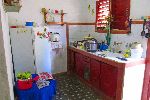 It
is a continuing fascination how our hosts can produce delicious, copious,
multi-dish meals out of very small and simple kitchens. Often the major
"appliances" are a rice cooker, pressure cooker and a two-burner,
counter-top hotplate. Ovens are virtually non-existent. The meals are
truly a work of magic.
It
is a continuing fascination how our hosts can produce delicious, copious,
multi-dish meals out of very small and simple kitchens. Often the major
"appliances" are a rice cooker, pressure cooker and a two-burner,
counter-top hotplate. Ovens are virtually non-existent. The meals are
truly a work of magic. 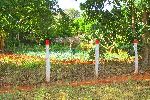
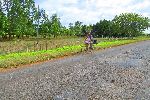
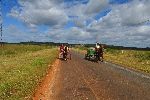
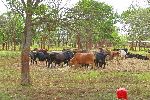
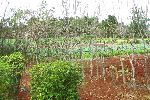
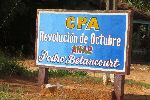
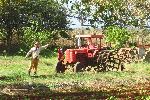
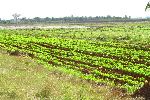
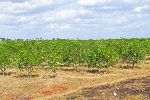
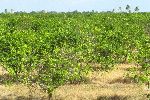
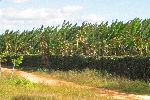 In
areas that used to have sugar cane planted to the horizons, as the price of
sugar has dropped, higher value substitutes have been planted. There are now
citrus trees (primarily oranges, but also grapefruit, lemon and lime) planted to
the horizons. Banana, mango, guava and other tropical fruits are also part of
the mix.
In
areas that used to have sugar cane planted to the horizons, as the price of
sugar has dropped, higher value substitutes have been planted. There are now
citrus trees (primarily oranges, but also grapefruit, lemon and lime) planted to
the horizons. Banana, mango, guava and other tropical fruits are also part of
the mix.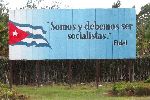
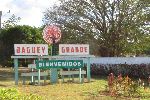
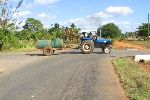
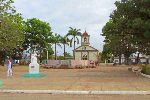
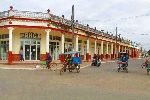
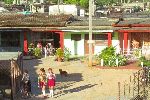 Jaguey
Grande seems to have the Goldilocks milieu of a healthy economy, healthy
lifestyle and good civic management; commercial space is occupied, homes are in
good repair, the central plaza is clean and maintained, and as a bonus,
non-motorized travel dominates.
Jaguey
Grande seems to have the Goldilocks milieu of a healthy economy, healthy
lifestyle and good civic management; commercial space is occupied, homes are in
good repair, the central plaza is clean and maintained, and as a bonus,
non-motorized travel dominates.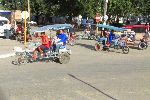
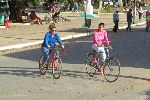
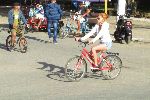
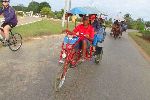
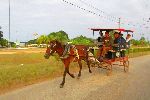
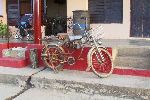
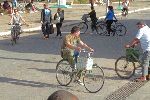
![]() Please write if you have questions, comment, criticism, praise or
additional information for us, find a bad link or would like to be added to IBF's mailing list. (Also let
us know how you found this site.)
Please write if you have questions, comment, criticism, praise or
additional information for us, find a bad link or would like to be added to IBF's mailing list. (Also let
us know how you found this site.)
![]() IBF Homepage
IBF Homepage
![]() Cuba
Homepage
Cuba
Homepage ![]() Search
ibike
Search
ibike



